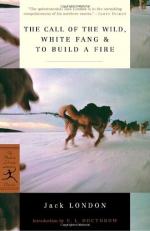
|
| Name: _________________________ | Period: ___________________ |
This test consists of 15 multiple choice questions and 5 short answer questions.
Multiple Choice Questions
1. The protagonist had been out in how many cold snaps before, according to the narrator in Part II?
(a) 2
(b) 5
(c) 11
(d) 8
2. What had been the protagonist’s response when the old-timer told him how cold it could get in the country?
(a) He cried
(b) He got angry
(c) He thanked him for the warning
(d) He laughed at him
3. The dog’s instincts tell him that walking in this cold is not good and that it is the time to do what, in Part III?
(a) Lay in the sun
(b) Burrow in the snow
(c) Hide behind a windbreak
(d) Curl up behind a tree
4. When the protagonist gets up to leave after his lunch, he takes the creek trail in which direction in Part III?
(a) Up the left fork
(b) Up the right fork
(c) Up the center fork
(d) Downstream
5. When did the Klondike Gold Rush begin?
(a) 1897
(b) 1912
(c) 1845
(d) 1872
6. What does the protagonist do in order to get the dog to come with him when he departs from eating lunch in Part III?
(a) Claps
(b) Whistles
(c) Fires a pistol
(d) Yells
7. Which word from Part III means anticipation of adversity or misfortune?
(a) Peremptorily
(b) Irony
(c) Conflagration
(d) Apprehension
8. The narrator states that the only caresses the dog has known were the caresses of what, in Part III?
(a) The rain
(b) The wind
(c) The whip-lash
(d) Strangers
9. The day is described as having broken exceedingly how in the opening of To Build a Fire?
(a) Cloudy and miserable
(b) Cold and gray
(c) Sunny and warm
(d) Misty and wet
10. What location is 1,000 miles north along the “dark hair-line” of the main trail visible in Part I?
(a) Inuvik
(b) Nulato
(c) Whitehorse
(d) Beaver Creek
11. The trek that the protagonist takes is expected to last how long?
(a) 9 hours
(b) 5 hours
(c) 2 hours
(d) 14 hours
12. What type of dog travels with the protagonist?
(a) Burmese Mountain Dog
(b) Newfoundland
(c) German Shepherd
(d) Husky
13. What does the protagonist do after finishing his lunch in Part III?
(a) Lights a pipe
(b) Watches the clouds
(c) Drinks some whiskey
(d) Takes a nap
14. In literature, what refers to the author's providing of some background information to the audience about the plot, characters' histories, setting, and theme?
(a) Exposition
(b) Rising action
(c) Climax
(d) Foreshadowing
15. The protagonist turns aside from what main trail to climb the high earth-bank to a “dim and little-traveled trail” in Part I?
(a) The Arctic Trail
(b) The Apache Trail
(c) The Alaska Trail
(d) The Yukon trail
Short Answer Questions
1. What refers to an obstacle located outside the protagonist, including nature, the supernatural, or society?
2. Naturalism was a literary movement that emerged in what decade?
3. What color are the protagonist’s beard and moustache?
4. What is a literary device in which an author indistinctly suggests certain plot developments that will come later in the story?
5. St. Michael is described as being located by what body of water in Part I?
|
This section contains 477 words (approx. 2 pages at 300 words per page) |

|




